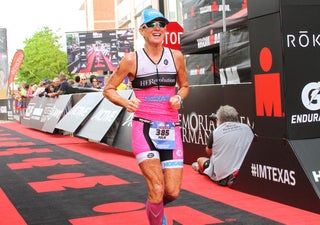Characters of Kona: Julie Moss

Julie Moss crawls toward the finish line at the 1982 Ironman World Championship. Photo: Carol Hogan
It’s a hard video to watch. That now-infamous Wide World of Sports ABC telecast from 1982 showing grad student Julie Moss go from the ecstasy of an easy win in Kona to the absolute agony of a complete physical shutdown on Ali’i Drive. The thin, young redheaded 23-year-old started the Hawaii Ironman Championships as a part of her thesis on physiology and training but ended it as an experiment in suffering.
And yet something about Moss’ collapse struck a chord. She went from a nearly 20-minute lead over Kathleen McCartney in T2 to requiring immediate medical attention over a few final miles. The island transformed Moss from an elite—a freak of nature that few could relate to—to a human who could barely function.
It all happened so fast. “I was flirting with the cameraman, thinking I was the ‘it’ girl,” laughs Moss, as she animatedly talks about her time at the front of the race. We’re sitting literally a few hundred meters from her famous march to the finish line, as she describes the beginning of the end. “At the turnaround at 18 miles, I saw Kathleen,” says Moss. “I felt that this person was running me down.” Moss’ admitted lack of a competitive background didn’t prepare her for what she was experiencing that day in Hawaii. “It was terrifying,” she leans in and confides, without a hint of melodrama.
It was that terror and lack of experience that led Moss to dig too deep, too fast, for too long.
In fact, the crowd surrounding the finish line likely knew what was happening before Moss did. “They were bringing in the women’s winner—me,” says Moss. “When the unthinkable happened.” (A hush fell over the crowd.) “A breakdown was happening from the legs up, so my head knew what was happening from the beginning.” In other words, Moss felt it all.
Moss suffered from a perfect storm of dehydration, malnutrition, and extreme exhaustion—something the grad student would have likely noted in her thesis, had she been observing.
She wobbled and fell, wobbled, and fell again. But this time she didn’t get up. “I had completely given up at that point,” she says. “I wanted to disappear.”
“But then something changed,” she whispers. “I got up, and I realized that if I could get up, I could walk. If I could walk, I could run. If I could run, I could finish.” Despite being passed by McCartney in the final hundred meters (McCartney contends that in the chaos and darkness, she had no idea what was happening to Moss), Moss began one of the most heroic and defining marches in the sport of triathlon.
“This was no longer about winning,” she says pointedly. There was no more flirting with the cameraman. “This was about just getting to the line.”
From the moment she finally crossed that finish line in second place like a newborn foal, things would be different for Julie Moss. At the awards ceremony that followed, she says that the crowd stood and applauded the ackowledgment of her runner-up performance. “I knew then that this was going to change my life.”
Despite the lack of Internet in those days, word spread of the young ironwoman and her courageous finish. A few weeks later, ABC aired its national coverage of the event—highlighting Moss’ struggle from start to finish—and from the word-of-mouth stories and still pictures, a moving human body emerged from the footage and made the event real for millions.
From there, Moss became an icon, personifying the unique struggle that the Hawaii Ironman presents. Her unspoken message was twofold: First, the island doesn’t care who you are or how far ahead you are; second, and most importantly, this race can offer redemption to those who dig deep enough to ask for it.
Without overstating her moment on Ali’i, Moss’ crawl helped ignite the first boom of the sport in the U.S. She became part of a “band of gypsies, who were pinching ourselves for living this dream.” This core group included other icons of the sport like Dave Scott, Scott Molina, Scott Tinley, and Mark Allen (whom Moss eventually married, then later separated from) who traveled around the world, racing and spreading the gospel of tri.

Today, Julie Moss has come full circle: Julie Moss, the athlete, has returned to race Kona several times. She raced in 2012, but admits “it wasn’t the race I wanted to end my career on.” When she received a special invitation to race Kona at the beginning of 2017, that same tenacious attitude that took her those hellish few hundred meters kicked in, and she instead earned her way to Kona with an incredible age group win at Ironman Texas.
In the years that followed her iconic status in the sport, she admittedly struggled with the weight of that mantle, but upon her last return to Kona, she found peace. The same person that made the sport so much to so many people over the years went back for the same reason she originally stood on that starting line back in 1982: “I’m an athlete. I can finally embrace that people see me and think that I’m a piece of the sport.”